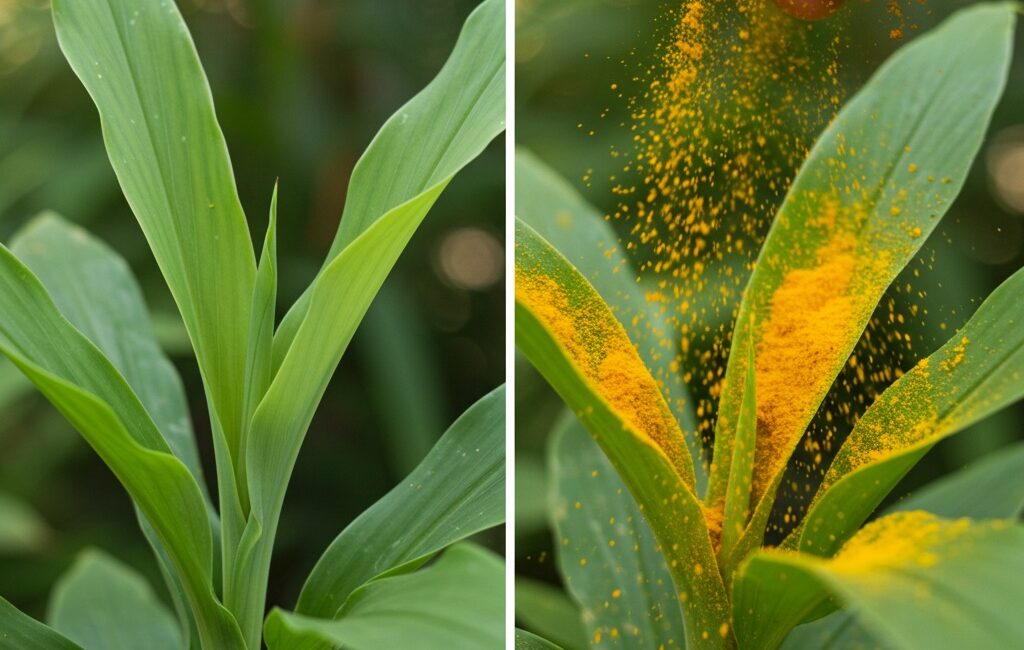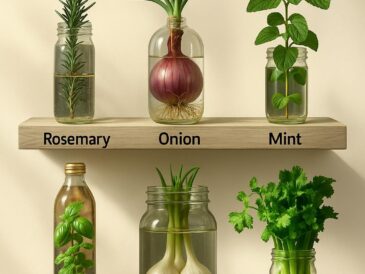Turmeric, often referred to as “the golden spice,” is a well-known culinary ingredient praised for its health benefits and vibrant color. It is also gaining recognition in the world of gardening, where it is being used as a powerful natural remedy to protect and nurture plants. In an age where people are becoming increasingly aware of the harmful effects of chemical pesticides and fertilizers, turmeric offers a natural and effective alternative. From repelling pests to promoting healthy growth, this humble spice can work wonders in your garden.
In this article, we’ll explore 10 surprising ways you can use turmeric to benefit your plants. Whether you’re dealing with pests, fungal infections, or simply looking to boost your plants’ growth, turmeric can play a key role in maintaining a healthy, thriving garden.
1. Powerful Natural Ant Repellent
Ants can be a real nuisance in the garden, especially when they start invading plant beds, disturbing the soil, and interfering with the root systems of your plants. Turmeric’s strong, earthy smell is a natural deterrent to ants, causing them to flee from areas where it’s sprinkled.
How to Use:
To create a simple ant repellent, sprinkle turmeric powder around your plants and on the surface of the soil. A little turmeric goes a long way, so be sure to use it sparingly. The pungent scent will help drive ants away without harming your plants or the environment.
Why It Works:
Ants are sensitive to strong scents and turmeric’s distinctive smell acts as a barrier. Additionally, the powder’s vibrant color can also deter ants, making your garden a less inviting place for them. This method is a great alternative to chemical-based repellents that might harm beneficial insects.
2. Repels Mealybugs
Mealybugs are tiny, cotton-like pests that can cause serious damage to plants. They typically hide under leaves and suck the sap from plants, weakening them over time. Interestingly, ants often protect mealybugs because they harvest the sweet honeydew they secrete. By repelling ants with turmeric, you also deter mealybugs indirectly.
How to Use:
Sprinkle turmeric powder around your plants to repel both ants and mealybugs. The mealybugs will be less likely to infest your plants because the ants, who normally protect them, will be driven away by the turmeric.
Why It Works:
Turmeric acts as a natural pest repellent, and by preventing ants from interacting with the mealybugs, you reduce the likelihood of these pests harming your plants. It’s a two-fold defense system that helps keep your garden healthy.
3. Natural Pesticide
Many garden pests, such as cabbage loopers and gray worm larvae, can wreak havoc on your plants. While chemical pesticides are often used to tackle these pests, they can also harm beneficial insects, pollinators, and the soil. Turmeric, however, offers a natural alternative to synthetic chemicals, serving as a pesticide that is effective and safe for the environment.
How to Use:
Sprinkle turmeric powder around the base of affected plants, especially if you see pests feeding on the leaves or stems. The powder will create a barrier that deters pests and helps reduce their numbers.
Why It Works:
Turmeric contains compounds like curcumin, which have been shown to have insecticidal properties. By using turmeric as a pesticide, you can protect your plants without resorting to harmful chemicals that can disrupt the balance of nature in your garden.
4. Effective Antifungal
Fungal infections are a common problem in gardens, leading to diseases like rust, powdery mildew, and blight. These fungi thrive in damp, warm conditions and can spread quickly, damaging plants and even killing them if left untreated. Turmeric’s natural antifungal properties make it an excellent remedy for combating plant diseases caused by fungi.
How to Use:
To create a natural antifungal spray, mix 2 teaspoons of turmeric powder in 1 liter of water. Pour the mixture into a spray bottle and apply it to the affected plants, focusing on areas where fungal growth is visible.
Why It Works:
Turmeric contains curcumin, a compound known for its antifungal properties. By using turmeric as a spray, you can inhibit the growth of harmful fungi and protect your plants from disease. This natural solution is safe for both your plants and the surrounding environment.
5. Treats Leaf Spots
Leaf spots are dark, often circular patches that appear on plant leaves. They are usually caused by fungal or bacterial infections and can weaken the plant over time. Turmeric spray is an effective remedy for treating black spots on leaves, helping to halt the spread of the infection and promote healing.
How to Use:
To treat leaf spots, mix 2 teaspoons of turmeric powder in 1 liter of water. Pour the mixture into a spray bottle and spray it directly onto the affected leaves. Be sure to cover both sides of the leaves and repeat the application as needed.
Why It Works:
Turmeric’s antifungal and antibacterial properties help fight the pathogens responsible for leaf spots. The curcumin in turmeric prevents the spread of the infection, allowing your plant to heal and thrive. Using turmeric as a leaf spot treatment is a natural and gentle way to care for your plants.
6. Treats Powdery Mildew
Powdery mildew is a common fungal infection that affects many garden plants, especially those with soft, succulent leaves like squash, cucumbers, and beans. The white, powdery spots that appear on the leaves are not only unsightly but can also hinder photosynthesis, ultimately weakening the plant. Turmeric, when combined with other natural ingredients, can effectively combat powdery mildew and promote healthier plants.
How to Use:
To treat powdery mildew, mix 2 teaspoons of turmeric powder, 100 ml of milk, and 2 teaspoons of white vinegar in 1 liter of water. Pour this mixture into a spray bottle and apply it to the leaves and stems of the affected plant. Repeat the treatment as necessary.
Why It Works:
Turmeric’s antifungal properties work in tandem with the mild acidity of vinegar and the proteins in milk to combat the powdery mildew fungus. This mixture helps to clear up the infection, allowing your plants to recover and continue to grow strong.
7. Prevents Rose Bush Dieback
Rose bushes are susceptible to a variety of diseases, including dieback, which causes the stems and branches to wither and die. One way to prevent this is by using turmeric as a treatment for cuts and wounds on rose branches. The antiseptic properties of turmeric help prevent infections from taking hold and promote healing.
How to Use:
To prevent dieback in rose bushes, prepare a thick paste by mixing turmeric powder with a small amount of water. Apply this paste to the cut end of the branch or stem to protect the wound and prevent infection.
Why It Works:
Turmeric’s antiseptic properties help to disinfect the wound, preventing harmful bacteria and fungi from entering the plant and causing disease. The turmeric paste creates a protective barrier, allowing the plant to heal naturally.
8. Prevents Root Rot
Root rot is a common problem for plants, particularly those that are overwatered or grown in poorly draining soil. It occurs when the roots become waterlogged, leading to the growth of harmful fungi that can rot the roots and ultimately kill the plant. Turmeric can help prevent root rot by promoting healthy root systems and discouraging fungal growth.
How to Use:
For potted plants, mix 1 tablespoon of turmeric into 5 liters of potting soil. For in-ground plants, water the soil with a mixture of 1 teaspoon of turmeric powder dissolved in 1 liter of water. Apply this solution around the base of the plant to protect the roots from rot.
Why It Works:
Turmeric’s antifungal properties inhibit the growth of harmful fungi that cause root rot. By incorporating turmeric into the soil, you can create a healthier, more balanced growing environment for your plants, reducing the risk of root rot.
9. Heals Plant Wounds
Just like humans, plants can get injured. Whether from pruning, storms, or other accidents, plant wounds can become entry points for harmful pathogens. Turmeric’s antiseptic properties make it an ideal remedy for helping to heal plant wounds and protect them from infection.
How to Use:
To treat plant wounds, prepare a paste by mixing turmeric powder with water. Apply this paste directly to the wound and cover it with grafting tape or plant bandages if necessary. This will protect the wound and promote healing.
Why It Works:
Turmeric contains curcumin, a compound with strong antiseptic properties that help prevent infections from taking hold. By applying turmeric to the wound, you create a natural barrier that speeds up the healing process and protects the plant from further damage.
10. Promotes Root Development
Turmeric can be used to stimulate root development in plant cuttings. It acts similarly to rooting hormones, encouraging roots to grow and helping cuttings establish themselves more effectively. This is particularly useful when propagating plants or trying to grow new plants from cuttings.
How to Use:
When planting cuttings, add 1 tablespoon of turmeric to the potting soil. The turmeric will help promote healthy root growth and encourage the cutting to establish itself more quickly.
Why It Works:
Turmeric stimulates root growth by providing essential nutrients and encouraging cell growth. It also helps protect the cutting from potential diseases, making it easier for the plant to establish itself and thrive.
Conclusion: The Gardener’s Secret Remedy
Turmeric is not just a flavorful spice that enhances your cooking; it is also a versatile, natural remedy that can help you maintain a healthy, thriving garden. From repelling ants and mealybugs to promoting healthy root development, turmeric offers a range of benefits for your plants. By incorporating turmeric into your gardening routine, you can avoid the harmful chemicals found in conventional pesticides and fertilizers while still achieving great results.
Whether you’re looking to combat pests, treat plant diseases, or boost growth, turmeric can serve as your secret gardening weapon. So, the next time you step into your garden, reach for the turmeric and watch your plants flourish!




